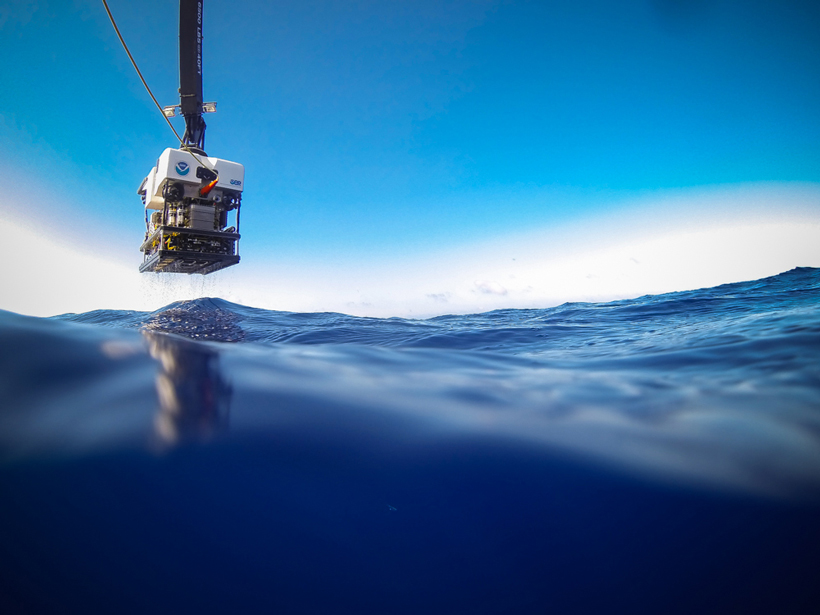Citing threats of overfishing and pollution to our oceans, as well as ocean ignorance so deep that our seafloor maps are worse than our maps of the surface of the Moon, the XPRIZE organization and cosponsors from industry and government today launched a new contest in XPRIZE’s Ocean Initiative series. The new competition challenges tech- and science-savvy teams to rapidly develop autonomous exploration technologies to create bathymetric maps, produce high-resolution images of a specific object, and identify archeological, biological, or geological features.
During this 3-year Shell Ocean Discovery XPRIZE competition, teams will have 12 months to design and build their initial instruments and 18 months to complete two rounds of testing. Teams must show that they can control their autonomous technologies to a depth of 4000 meters. An expert panel will judge the performance of the teams’ entries.
The prize? Seven million dollars, mostly from Royal Dutch Shell, but including a $1 million bonus award from the National Oceanic and Atmospheric Administration (NOAA) for technology that can find a specific underwater object using biological or chemical signals.
XPRIZE chairman and CEO Peter H. Diamandis and representatives of Shell Oil and NOAA announced the new competition today at the annual Fall Meeting of the American Geophysical Union (AGU) in San Francisco, Calif.
Instinct to Explore
Oceans cover two thirds of Earth and provide food for about a billion people. The seas have always been a boon to discovery as well, Jyotika Virmani, XPRIZE’s senior director of energy and environment and prize operations, told Eos. Underwater explorers have discovered raw materials for medicines, and oceanographic research has uncovered vital knowledge about how Earth changes and evolves.
“Inherently, as a species, we’re explorers,” she said. “Until we do this discovery and exploration of the sea, we [won’t] know what’s down there.”
“Inherently, as a species, we’re explorers,” she said. “Until we do this discovery and exploration of the sea, we [won’t] know what’s down there.” Technologies developed in the competition might aid search and rescue operations, she added.
XPRIZE encourages all types of innovators to enter the competition, Virmani said. In all XPRIZE contests so far, established experts in a field are not the only competitors. “We have new players come forward,” she said. Although the rules don’t require expertise in ocean science or cartography, competitors will need to master not just mapping but also robotics, computer science, photography, digital imaging, data manipulation, and more, she noted.
Third Stage of 10-Year Initiative
With today’s announcement, XPRIZE launches the third in a series of five high-dollar competitions scheduled to occur by 2020, aimed at improving ocean health and promoting appreciation and understanding of oceans, said Virmani. XPRIZE held the first of those competitions in 2010 in response to the Deepwater Horizon oil spill and awarded $1.4 million to a group of scientists who demonstrated a technology that removed oil from water nearly 4 times faster than ever before. The next competition, launched in 2013 to improve the accurate measurement and understanding of ocean acidification, awarded $1.5 million to the company Sunburst Sensors for its accurate and affordable ocean pH sensor.
Michael DeGrandpre, a professor at the University of Montana in Missoula and cofounder of Sunburst Sensors, told Eos that the prize really pushed the team to work more quickly and efficiently. What might have been a 2- or 3-year project developing the pH sensor became a 1-year project, DeGrandpre said.
“In a lot of ways, the urgency wasn’t there until the XPRIZE came along.”
“In a lot of ways, the urgency wasn’t there until the XPRIZE came along,” he continued.
Since the Sunburst Sensors team won the XPRIZE in July of this year, a variety of businesses and other ventures have sought out the group for collaborations. Next year, athlete Ben Lecomte will use one of their portable pH sensors as he attempts an unprecedented swim across the Pacific Ocean to raise awareness about sustainability.
Teams have until June 2016 to register.
To find out more, visit https://oceandiscovery.xprize.org/ or watch the announcement on the AGU On-Demand webstream. Look for U13B Special General Session: XPRIZE Announcement 12:30–1:30 P.M., Monday, 14 December in the channel listings.
—JoAnna Wendel, Staff Writer
Citation: Wendel, J. (2015), Autonomous undersea technologies to vie for new XPRIZE, Eos, 96, doi:10.1029/2015EO041461. Published on 14 December 2015.
Text © 2015. The authors. CC BY-NC 3.0
Except where otherwise noted, images are subject to copyright. Any reuse without express permission from the copyright owner is prohibited.

